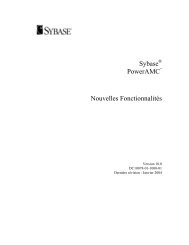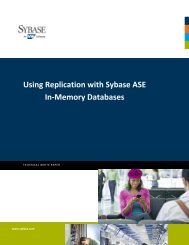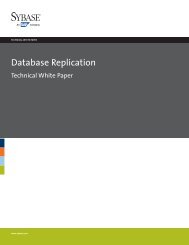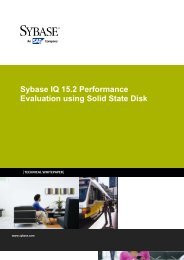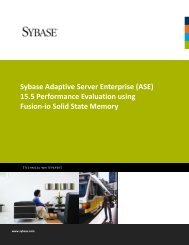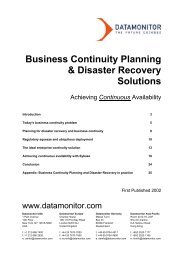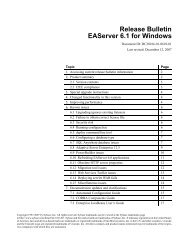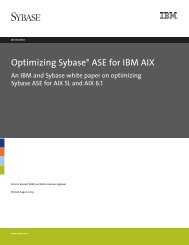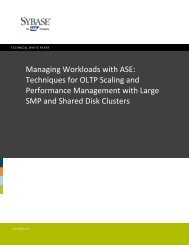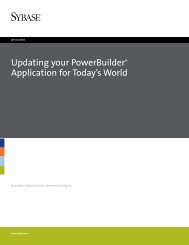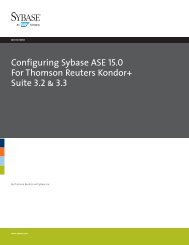A Practical Hardware Sizing Guide for Sybase IQ
A Practical Hardware Sizing Guide for Sybase IQ
A Practical Hardware Sizing Guide for Sybase IQ
Create successful ePaper yourself
Turn your PDF publications into a flip-book with our unique Google optimized e-Paper software.
Local Store Devices<br />
The current rule of thumb <strong>for</strong> determining the number of local store <strong>IQ</strong> devices (dbspaces) to<br />
allocate <strong>for</strong> a single host <strong>IQ</strong> configuration should follow this algorithm:<br />
<strong>IQ</strong>_dbspaces = 3 + ( number_of_singlehost_cores / 10 )<br />
This number should be rounded up to the next highest whole number.<br />
For example, a 4 core/CPU machine would need 3 + (4/10) or 3.4 devices. Rounded up, this<br />
system should have a minimum of 4 devices <strong>for</strong> the local store.<br />
<strong>IQ</strong> Device Placement<br />
It is recommended, but not mandatory, that the <strong>IQ</strong> main and temporary store devices be<br />
physically separated and not reside on the same LUNs and physical drives in the storage system.<br />
Primarily, we want to increase overall throughput and placing these devices on the same hard<br />
drives will cause thrashing. Secondarily, though, most storage systems have caching<br />
mechanisms that can be tuned by device. This allows <strong>for</strong> tuning the drive array caches<br />
differently <strong>for</strong> the different <strong>IQ</strong> device types.<br />
For additional in<strong>for</strong>mation on configuring storage devices, LUNs and, a SAN, search <strong>for</strong> “<strong>IQ</strong><br />
Reference Architecture <strong>Sizing</strong> <strong>Guide</strong>”, “Reference Architecture Implementation <strong>Guide</strong>”, and<br />
“NonStop<strong>IQ</strong>” on the http://www.sybase.com website search box.<br />
<strong>IQ</strong> Device Mapping<br />
When developing the <strong>IQ</strong> storage subsystem, it is important to size the entire storage system<br />
appropriately. It is also equally important <strong>for</strong> per<strong>for</strong>mance to segregate the workload between<br />
filesystems, main store, and temporary store devices. The segregation should include separate<br />
HBAs or I/O controllers as well as different paths through the SAN infrastructure. At the SAN,<br />
the physical disks or spindles should also not be shared with any other application.<br />
As an example, the following is a high level conceptual diagram of how the <strong>IQ</strong> storage could be<br />
laid out. The <strong>IQ</strong> main store is comprised <strong>for</strong> 4 different RAID 5 groupings. Each RAID 5<br />
grouping is a 5 disk RAID 5 (4+1 parity drive) configuration. The entire RAID group is presented<br />
as a single device to any machine connected to the SAN so that they see the entire storage<br />
content of those 4 disks (plus 1 <strong>for</strong> parity).<br />
The RAID 5 “disk” is presented to the OS as a LUN. That LUN is, in turn, used by <strong>IQ</strong> as a single<br />
dbspace. A logical volume manager (LVM) need not be present. If one is, it is the job of the<br />
LVM to present the original LUN to <strong>IQ</strong> as a single disk that hasn‟t been striped together with<br />
other devices.<br />
It is also important to keep in mind that in a multi-node <strong>IQ</strong> configuration multiple hosts will need<br />
to see the same <strong>IQ</strong> main store devices simultaneously. Adding ports and bandwidth to the SAN<br />
and SAN switches will be critical to per<strong>for</strong>mance as more nodes are added.<br />
Final<br />
30



